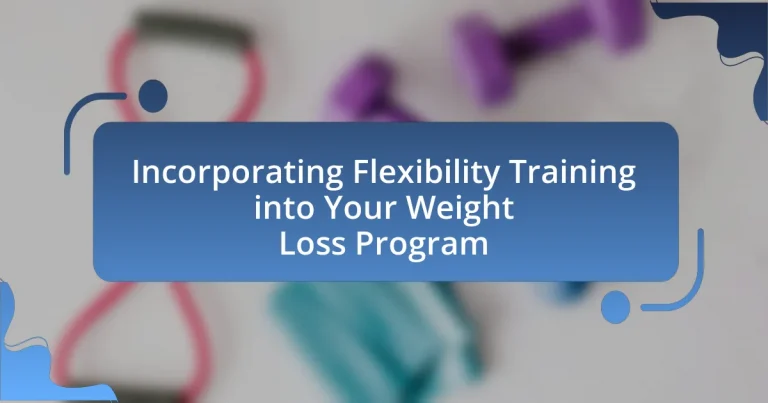Flexibility training is a crucial component of fitness that enhances the range of motion in joints and muscles, thereby improving overall movement and reducing injury risk. This article explores how flexibility training relates to weight loss by enhancing physical performance, promoting muscle recovery, and enabling more effective workouts. Key components of flexibility training, including static stretching, dynamic stretching, and proprioceptive neuromuscular facilitation (PNF), are discussed, along with their benefits for injury prevention and workout efficiency. Additionally, practical tips for integrating flexibility training into a weight loss program are provided, emphasizing the importance of consistency and goal-setting for optimal results.

What is Flexibility Training and How Does It Relate to Weight Loss?
Flexibility training involves exercises that enhance the range of motion in joints and muscles, promoting better overall movement and reducing the risk of injury. This type of training can relate to weight loss by improving physical performance, which may lead to more effective workouts and increased calorie expenditure. Research indicates that individuals who incorporate flexibility training into their fitness routines often experience enhanced muscle recovery and reduced soreness, allowing them to maintain a consistent exercise regimen. Consistency in exercise is crucial for weight loss, as it helps sustain a higher metabolic rate and supports overall fitness goals.
Why is Flexibility Training Important for Overall Fitness?
Flexibility training is important for overall fitness because it enhances the range of motion in joints, which can improve performance in physical activities and reduce the risk of injuries. Increased flexibility allows for better movement efficiency and can lead to improved athletic performance, as evidenced by a study published in the Journal of Strength and Conditioning Research, which found that athletes with greater flexibility had better performance metrics in their respective sports. Additionally, flexibility training can alleviate muscle tension and promote relaxation, contributing to overall physical well-being.
What are the key components of flexibility training?
The key components of flexibility training include static stretching, dynamic stretching, and proprioceptive neuromuscular facilitation (PNF). Static stretching involves holding a stretch for a period, typically 15-60 seconds, to improve muscle elasticity and joint range of motion. Dynamic stretching incorporates movement and is often used as a warm-up to prepare muscles for activity, enhancing overall flexibility. PNF is a more advanced technique that combines stretching and contracting of the muscle group being targeted, which has been shown to increase flexibility more effectively than static stretching alone. Research indicates that incorporating these components can lead to improved performance and reduced injury risk, making them essential for a comprehensive flexibility training program.
How does flexibility training enhance physical performance?
Flexibility training enhances physical performance by improving the range of motion in joints, which allows for more efficient movement patterns. Increased flexibility reduces the risk of injuries during physical activities, as it enables muscles and tendons to stretch more effectively. Research indicates that athletes with greater flexibility can perform better in sports that require dynamic movements, such as gymnastics and dance, where a wide range of motion is crucial. Additionally, a study published in the Journal of Strength and Conditioning Research found that flexibility training can lead to improved strength and power output, as it allows for better muscle activation and coordination during performance.
How Can Flexibility Training Support Weight Loss Goals?
Flexibility training can support weight loss goals by enhancing overall physical performance and reducing the risk of injury, which allows for more consistent exercise. Improved flexibility enables individuals to perform a wider range of movements during workouts, leading to more effective calorie burning. Research indicates that incorporating flexibility exercises can increase muscle efficiency and promote better posture, which can enhance workout intensity and duration. A study published in the Journal of Strength and Conditioning Research found that individuals who included flexibility training in their routines experienced improved performance in strength and aerobic exercises, contributing to greater weight loss outcomes.
What role does flexibility play in injury prevention during weight loss programs?
Flexibility plays a crucial role in injury prevention during weight loss programs by enhancing the range of motion in joints and muscles, which reduces the risk of strains and sprains. Improved flexibility allows for better movement mechanics, enabling individuals to perform exercises with proper form and technique, thereby minimizing the likelihood of injury. Research indicates that incorporating flexibility training can lead to a decrease in injury rates; for instance, a study published in the Journal of Sports Medicine found that athletes who engaged in regular flexibility exercises experienced 30% fewer injuries compared to those who did not. This evidence supports the importance of flexibility in maintaining physical health and safety during weight loss efforts.
How does improved flexibility contribute to better workout efficiency?
Improved flexibility enhances workout efficiency by allowing for a greater range of motion during exercises. This increased range enables individuals to perform movements more effectively, leading to better muscle engagement and reduced risk of injury. Research indicates that flexibility training can improve overall athletic performance, as evidenced by a study published in the Journal of Strength and Conditioning Research, which found that athletes with greater flexibility demonstrated improved power and speed in their movements. Thus, incorporating flexibility training into a workout regimen not only optimizes performance but also contributes to safer and more effective exercise sessions.

What Types of Flexibility Training Can Be Incorporated into a Weight Loss Program?
Types of flexibility training that can be incorporated into a weight loss program include static stretching, dynamic stretching, and proprioceptive neuromuscular facilitation (PNF). Static stretching involves holding a stretch for a period, which can improve overall flexibility and reduce injury risk, thereby supporting consistent exercise routines essential for weight loss. Dynamic stretching incorporates movement and is often used as a warm-up, enhancing blood flow and preparing muscles for more intense workouts, which can lead to increased calorie burn. PNF involves both stretching and contracting the targeted muscle group, which has been shown to improve flexibility more effectively than static stretching alone. Research indicates that incorporating these types of flexibility training can enhance overall fitness and support weight loss efforts by improving range of motion and reducing muscle soreness, thus promoting adherence to exercise programs.
What are the different methods of flexibility training?
The different methods of flexibility training include static stretching, dynamic stretching, ballistic stretching, and proprioceptive neuromuscular facilitation (PNF). Static stretching involves holding a stretch for a period, typically 15-60 seconds, to improve overall flexibility. Dynamic stretching incorporates movement and is often used as a warm-up to prepare muscles for activity. Ballistic stretching uses momentum to push the body beyond its normal range of motion, which can increase flexibility but also carries a higher risk of injury. PNF involves both stretching and contracting the muscle group being targeted, often requiring a partner, and is considered one of the most effective methods for increasing flexibility. Each method serves distinct purposes and can be integrated into a weight loss program to enhance overall physical performance and reduce injury risk.
How does static stretching differ from dynamic stretching?
Static stretching involves holding a muscle in a lengthened position for a period of time, typically 15 to 60 seconds, to improve flexibility and increase range of motion. In contrast, dynamic stretching consists of controlled movements that gently take muscles and joints through their full range of motion, often performed as part of a warm-up routine to prepare the body for physical activity. Research indicates that static stretching can temporarily decrease muscle strength and power if performed immediately before an activity, while dynamic stretching has been shown to enhance performance by increasing blood flow and muscle temperature.
What are the benefits of incorporating yoga into a weight loss program?
Incorporating yoga into a weight loss program enhances physical fitness, promotes mindfulness, and reduces stress, all of which contribute to effective weight management. Yoga improves flexibility and strength, which can lead to increased calorie burn during workouts. A study published in the Journal of Physical Activity and Health found that individuals who practiced yoga regularly experienced greater weight loss and improved body composition compared to those who did not. Additionally, yoga encourages mindfulness, helping individuals develop a better relationship with food and reduce emotional eating, further supporting weight loss efforts.
How can you effectively integrate flexibility training into your existing routine?
To effectively integrate flexibility training into your existing routine, schedule dedicated sessions for stretching or mobility exercises at least three times a week. Research indicates that consistent flexibility training can enhance overall performance and reduce injury risk, making it a valuable addition to any fitness regimen. For instance, a study published in the Journal of Strength and Conditioning Research found that participants who incorporated flexibility training improved their range of motion and athletic performance significantly. By combining flexibility exercises with your current workouts, such as performing dynamic stretches before and static stretches after your main training sessions, you can seamlessly enhance your flexibility while supporting your weight loss goals.
What are some recommended flexibility exercises for beginners?
Some recommended flexibility exercises for beginners include the standing quadriceps stretch, seated hamstring stretch, butterfly stretch, and cat-cow stretch. These exercises target major muscle groups and improve overall flexibility. The standing quadriceps stretch helps to stretch the front of the thigh, while the seated hamstring stretch focuses on the back of the leg. The butterfly stretch opens up the hips, and the cat-cow stretch enhances spinal flexibility. Incorporating these exercises into a routine can lead to improved range of motion and reduced risk of injury, which is essential for effective weight loss programs.
How often should flexibility training be performed for optimal results?
Flexibility training should be performed at least two to three times per week for optimal results. This frequency allows for sufficient muscle recovery and adaptation, enhancing overall flexibility and reducing the risk of injury. Research indicates that consistent flexibility training can improve range of motion and muscle performance, which is essential for effective weight loss programs. A study published in the Journal of Strength and Conditioning Research found that participants who engaged in flexibility training two to three times weekly showed significant improvements in flexibility compared to those who trained less frequently.

What Are the Best Practices for Incorporating Flexibility Training into Your Weight Loss Program?
The best practices for incorporating flexibility training into a weight loss program include integrating stretching exercises into your routine, focusing on dynamic stretches before workouts, and static stretches post-exercise. Flexibility training enhances muscle recovery, reduces injury risk, and improves overall performance, which can contribute to more effective weight loss. Research indicates that individuals who engage in regular flexibility training experience improved range of motion and muscle function, leading to better workout efficiency and calorie expenditure. For example, a study published in the Journal of Strength and Conditioning Research found that flexibility training can enhance athletic performance and support weight management efforts.
How can you measure the effectiveness of flexibility training on weight loss?
The effectiveness of flexibility training on weight loss can be measured through changes in body composition, specifically by tracking reductions in body fat percentage and overall weight. Research indicates that while flexibility training alone may not lead to significant weight loss, it can enhance overall fitness and support weight loss efforts when combined with aerobic and strength training. For instance, a study published in the Journal of Sports Science & Medicine found that participants who incorporated flexibility exercises into their routine experienced improved muscle recovery and performance, which can indirectly contribute to more effective weight loss strategies. Additionally, measuring progress through regular assessments, such as body measurements and fitness tests, can provide concrete evidence of the impact of flexibility training on weight loss outcomes.
What signs indicate that flexibility training is positively impacting your weight loss journey?
Signs that flexibility training is positively impacting your weight loss journey include improved range of motion, increased muscle recovery, and enhanced overall workout performance. Improved range of motion allows for more effective exercise execution, which can lead to higher calorie expenditure. Increased muscle recovery reduces soreness and enables more frequent workouts, contributing to greater weight loss. Enhanced overall workout performance, such as increased strength and endurance, can lead to more intense and longer exercise sessions, further promoting weight loss. Studies have shown that individuals who incorporate flexibility training into their routines often experience these benefits, supporting their weight loss efforts.
How can you adjust your flexibility training based on progress?
To adjust your flexibility training based on progress, regularly assess your range of motion and comfort levels during stretches. If you notice improvements, such as increased flexibility or reduced discomfort, you can incorporate more advanced stretches or increase the duration of your current routine. Research indicates that individuals who progressively challenge their flexibility training see greater gains; for example, a study published in the Journal of Strength and Conditioning Research found that participants who increased their stretching intensity over time improved their flexibility by 20% more than those who maintained the same routine. Therefore, tracking your progress and modifying your training accordingly is essential for continued improvement in flexibility.
What common challenges might arise when incorporating flexibility training?
Common challenges that might arise when incorporating flexibility training include time constraints, lack of motivation, and potential discomfort during stretching exercises. Time constraints can hinder individuals from dedicating sufficient time to flexibility routines, which are essential for effective training. Lack of motivation may stem from not seeing immediate results, leading to decreased adherence to the training program. Additionally, discomfort or pain during stretching can discourage individuals from continuing their flexibility training, as they may associate it with negative experiences. These challenges can impede the successful integration of flexibility training into a weight loss program.
How can you overcome time constraints to include flexibility training?
To overcome time constraints and include flexibility training, prioritize short, effective sessions that can be integrated into your existing routine. Research indicates that even 10-15 minutes of targeted stretching or yoga can significantly improve flexibility and overall fitness. For instance, a study published in the Journal of Sports Science and Medicine found that brief flexibility sessions, when performed consistently, yield substantial benefits in muscle elasticity and joint range of motion. By scheduling these short sessions during breaks or combining them with other workouts, individuals can effectively incorporate flexibility training without requiring extensive time commitments.
What strategies can help maintain motivation for flexibility training?
To maintain motivation for flexibility training, setting specific, achievable goals is essential. Research indicates that individuals who establish clear objectives are more likely to stay committed to their training regimen. For instance, a study published in the Journal of Sport & Exercise Psychology found that goal-setting significantly enhances motivation and performance in physical activities. Additionally, incorporating variety into flexibility routines can prevent boredom and sustain interest; changing exercises or environments can keep the training engaging. Tracking progress through measurable outcomes, such as increased range of motion or improved performance in other physical activities, also reinforces motivation by providing tangible evidence of improvement.
What practical tips can enhance your flexibility training experience?
To enhance your flexibility training experience, incorporate dynamic stretching before workouts and static stretching afterward. Dynamic stretching prepares muscles for activity, improving range of motion and reducing injury risk, while static stretching post-exercise aids in muscle recovery and increases flexibility over time. Research indicates that dynamic stretching can improve performance in activities requiring strength and power, as shown in a study published in the Journal of Strength and Conditioning Research, which found that athletes who performed dynamic stretches had better performance outcomes compared to those who did not.

